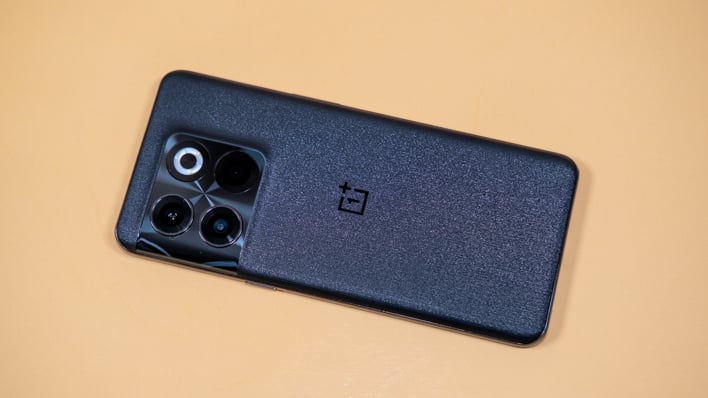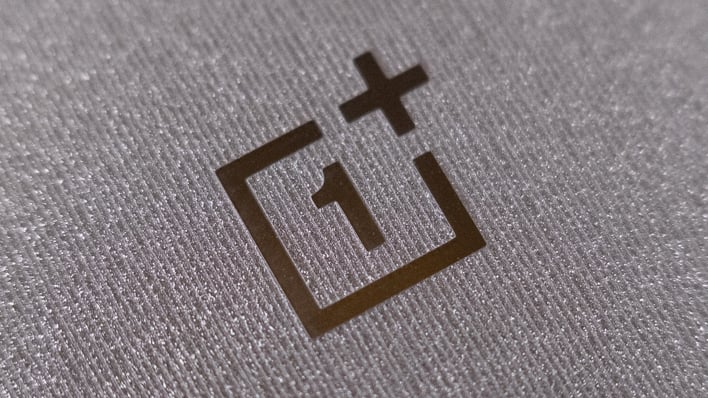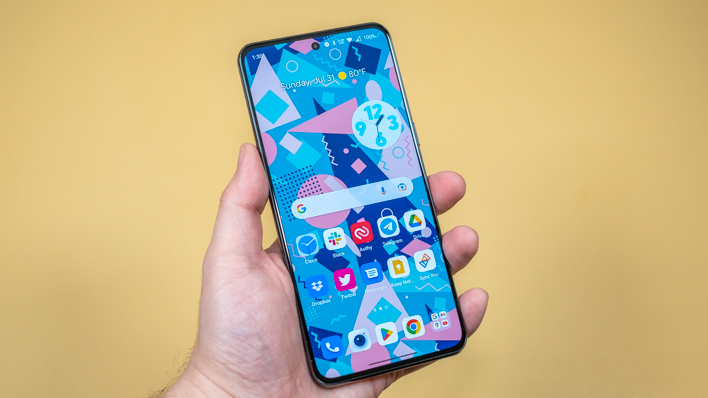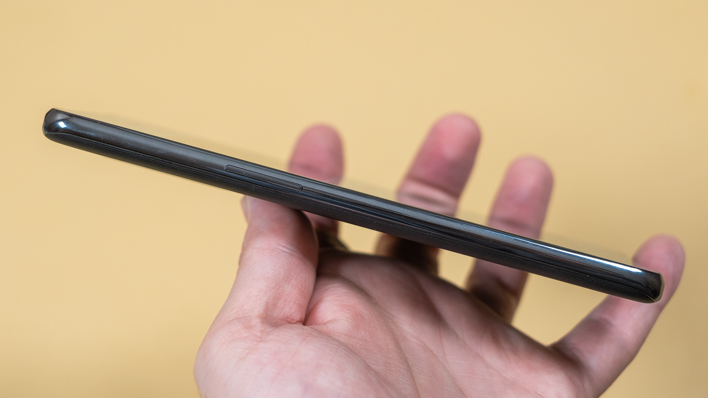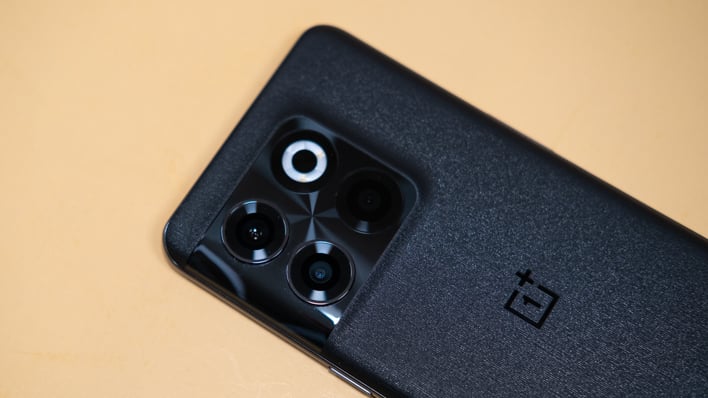OnePlus 10T Review: Crazy-Fast Phone, Charges Even Faster
In that regard, the OnePlus 10T could have an alert slider, though it does not. It could also have wireless charging, a feature OP has been so proud to show off in recent years, though it doesn't. Although, at the same time, it's a sleek, powerful, well-made piece of hardware with a solid OLED screen, and its 125 Watt wired charging speed is mind-blowing. The biggest problem OnePlus faces is not the speeds and feeds—it's the software. The current version of OxygenOS is not as refined as it used to be, but OnePlus has promised to change that.
OnePlus has priced this phone at $650, which is a harder sell when you can get phones like the Pixel 6 at the same price. In addition, Google's device is pretty fantastic in the photography department, despite both devices having similar 50MP main sensors. Can the OnePlus 10T's ultra-fast performance, charging chops and top-notch build help it compete? Let's take a look...
| SoC |
Snapdragon 8+ Gen 1 (4 nm) |
| Display | 6.7-inch 2412 x 1080 OLED, up to 120Hz |
| Memory |
8, 16GB LPDDR5 |
| Storage |
128, 256GB UFS 3.1 |
| Rear-Facing Cameras |
50MP primary (Sony IMX766, OIS, f/1.8), 8MP ultrawide ( 119.9 degrees, f/2.2), 2MP macro |
| Front-Facing Cameras |
16MP f/2.4 |
| Video Recording |
Up to 4K 60FPS |
| Battery |
4,800mAh, 125W SuperVOOC charging |
| Authentication |
In-display fingerprint reader (optical) |
| OS |
Android 12 (OxygenOS 12.1) |
| Dimensions |
163 mm × 75.37mm × 8.75 mm |
| Weight |
203.5g |
| Dust/Water Resistance |
IP54 |
| Connectivity |
802.11ax Wi-Fi 6, Sub-6GHz 5G, Bluetooth 5.3 |
| Colors |
Moonstone Black, Jade Green |
| Pricing |
Starting at $649 |
OnePlus, now under the watchful guide of Oppo, has shown that it knows how to make a solid hunk of mobile technology. The OnePlus 10T feels luxurious—the power button is stable and has just the right click, and the display's glass drops away ever so smoothly around the flat 6.7-inch OLED panel.
Around back, the 10T still sports the stovetop-style camera island, and this time it's more blended into the back of the device for a less pronounced bump versus the OnePlus 10 Pro. That said, the texture of the Gorilla Glass rear panel is a little bizarre with the "Moonstone Black" model we've been testing. It's heavily textured, allegedly to simulate the feel of basalt. To us, it's reminiscent of the feel of 3D printed plastic. We don't love it but this is highly subjective, and of course if you aren't a fan, OnePlus still makes great cases. Or you can get the green model, which has a smooth ceramic-like finish. It's also just a more interesting color, but again, that's subjective.
Increasingly, OnePlus phones are losing the things that made them unique in an industry that has settled on a single form factor. The OnePlus 10T makes the trendline clear with its missing alert slider. Ever since the OnePlus 2, the company has included this wonderful hardware feature, but the 10T has lost this once standard piece of equipment. We understand there are space-saving reasons to remove the slider, but it seems worthy of however much space it took up in previous models. Thankfully, OnePlus says this is not the end of the alert slider—future OnePlus phones will still have it.
As we talk about the specs, keep in mind this is a T-series OnePlus phone, not a "Pro" device. OnePlus says there are no plans for a 10T Pro, and that means some of the hardware will be a clear step down from the last OP flagship. Case in point, the display. The 6.7-inch OLED clocks in at 2412 x 1080 (the 10 Pro was 1440p) with a 120Hz refresh rate. However, this is not an LTPO panel, which would allow for dynamic refresh adjustment between 1 and 120Hz. Instead, this screen can shift between 120, 90, and 60Hz, depending on the content, to save power.
That said, this is still a solid, high refresh rate smartphone display. Its colors are vibrant, the viewing angles are perfect, and its brightness gets up there with a maximum of 950 nits. It's not going to rival Samsung's latest phones with luminance readings approaching 2,000 nits, but it's perfectly readable in outdoor environments. As for the resolution, it doesn't look quite as crisp next to a 1400p screen, but you really have to pixel peep to notice during daily use, and the average mainstream consumer probably won't care.
OnePlus 10T: Built For Speed
The real story of this phone is the focus on speed. Inside, the 10T has the latest Snapdragon 8+ Gen 1 mobile platform. Qualcomm's new plus variant has been clocked 10% higher than the non-plus we have seen in most other 2022 flagship phones, and though its core configuration is unchanged, the chip has been further optimized for better power and thermal characteristics. On the CPU side, the Snapdragon 8+ Gen 1 has one 3.2GHz Cortex-X2, three 2.75 GHz Cortex-A710 cores, and four 2.0 GHz Cortex-A510s. The GPU is still an Adreno 730, but it's clocked at 900MHz instead of 818MHz. The memory spread is wider than usual for this OP phone—you get 8GB in the base model, and the step-up includes 16GB (this is the version we're testing). The $100 upgrade also doubles storage from 128GB to 256GB.However, the relentless focus on speed is most exemplified perhaps by this phone's charging speed. It runs on the latest SuperVOOC standard with a maximum speed of 125W. Yes, you read that right. We'll get into the specifics of charging later, but it means OnePlus basically had to include the necessary charger in the box. You get a 160W SuperVOOC brick and a three-foot USB-C-to-C cable with support for those super-high speeds. It's always nice to see OEMs including the bare essentials these days, so kudos for the extra value OnePlus brings here. You also get a pre-installed plastic screen protector on the OnePlus 10T, like it's 10 Pro sibling.
OxygenOS 12.1 Software Experience
The OnePlus 10T ships with OxygenOS 12.1, which is based on Android 12. This is the same version of Android that some OnePlus 9 owners have been trying to avoid installing for the last several months. Software used to be a strong point for OnePlus, but the latest version of OxygenOS looks and feels more like Oppo's ColorOS, which isn't exactly a compliment.Right from the start, there are small annoyances that grate on you the longer you use the phone. For example, removing an icon or widget from the home screen is a two-step process, and notification icons in the status bar will randomly render with color. OnePlus has also used an aggressive "shrinking" animation whenever you tap something on the home screen. The problem is, if you use any scrollable widgets, this animation makes them "jiggle" with every single swipe. The home screen also lacks the ability to set custom icon packs, which OnePlus phones have had for years before OxygenOS 12.

Oh, and then there's the Shelf, a UI that OnePlus used to insert where Google Discover now lives to the left of the home screen. We're happy OP moved away from this, but replacing part of the notification gesture area with the Shelf is not much better. If you swipe down on the right side of the status bar, you'll get the Shelf UI with its selection of OnePlus-specific widgets. You can add your own widgets, too, but we've never found this very useful. When we found ourselves staring at the shelf, nine times out of ten it was because we were trying to open the notifications and swiped too far to the right.
Android 12 adds support for Google's Material You theming engine, but it's almost entirely absent from the OnePlus 10T. Like the version of OxygenOS 12 that shipped on the 10 Pro, setting a background will bestow your OS with new accent colors, but you have no control over the color palettes like you do on Google or Samsung phones.
One place the 10T gets it right is with its update guarantee. OnePlus promises three Android OS updates, bringing the device up to Android 15 when the time comes. It will also get security updates for one year beyond that. We do hope OxygenOS 13 addresses some of the aforementioned shortcomings, however.
OnePlus 10T Cameras And Image Samples
OnePlus has pushed its Hasselblad partnership pretty hard over the last couple of years, but that branding is missing from the camera module on the 10T. The company is coy about the reason for this, but it could be a cost mitigation effort as well. Regardless, the 10T has a passable primary sensor in the 50MP Sony IMX766 (binned to 12MP output by default), but the 8MP ultrawide and 2MP macro are better suited for a phone that costs hundreds of dollars less.The primary shooter's wide f/1.8 aperture gives it respectable low-light performance, helped by both optical and electronic stabilization. OnePlus leans toward slightly longer exposure times compared to a Pixel, so moving subjects can prove more difficult to capture. The OnePlus 10T also lacks the magical image processing of Google's phones, which is a problem when you want to zoom in—the 10T can make fine details pretty muddy. We have found the 10T's HDR performance to be above average; the phone does a good job of managing white balance while avoiding blown-out areas, but it does tend to lose some detail in shadows.
I have tested a lot of dedicated macro cameras on phones, and I've never liked one. They are always too low-resolution, and cause your subject to become shrouded in shadow as you move in close. A better solution is to use an ultrawide sensor with autofocus for macro shots, but that would require a much more capable sensor than the one in this phone. It's no surprise OnePlus hides the macro mode away in the "more" section of the camera app. So, why even cram a third camera sensor on the phone?
OnePlus styled the 10T's camera module to look impressive, but the hardware didn't quite measure up. If you just want to take some snapshots, the 50MP primary sensor will get the job done, but don't expect Pixel-like miracles. And the rest of its sensors seem more like afterthoughts, so if you're really a smartphone camera junkie, the OnePlus 10T probably won't fit the bill. On the other hand, if you just want a quick point and shoot solution, this new OnePlus phone is serviceable for mainstream consumers.

